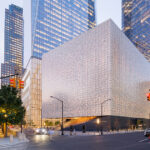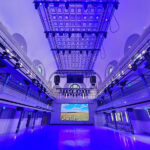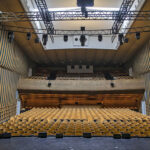It’s a familiar story, told countless times all over America. A 1920s-era theater starts life as a magnet for movie-goers, shifts with the times to become a famed concert venue, but falls on tougher times as the economy and entertainment models continue to shift. After years of under-use, it becomes a banquet hall or civic gathering space.
In Port Chester, NY, thanks to the efforts of music entrepreneur Peter Shapiro, that story has taken a different turn. Instead of continuing to serve as a catering hall for private functions or corporate events, the Capitol Theater is returning to prominence as a live music venue, with top acts like Bob Dylan, Lyle Lovett, Warren Haynes, The Roots and Trey Anastasio booked to perform.
Shapiro, in conjunction with promoter The Bowery Presents, have undertaken a massive renovation of the lighting, rigging, projection and sound systems to bring the historic venue into the 21st century.
 Act I: The Beginnings
Act I: The Beginnings
The Capitol Theatre, designed by Thomas Lamb, opened in 1926. It quickly became one of the top movie theaters in the region. With 1,800 seats and the “only theater refrigerating system in Westchester County,” The Cap, as the building is known locally, was a destination for crowds from miles around to come see classic films such as Casablanca, Gone with the Wind and countless others.
But times changed, and moviegoers no longer made an event out of a trip to the cinema, and The Cap had to follow suit. As movie theaters shrank and became more numerous, most venues of similar size became music halls. The Cap was no different, hosting some of the biggest names in rock ‘n’ roll history through the 1960s and 1970s. Legendary acts like The Rolling Stones, Janis Joplin and The Grateful Dead all played the historic venue before a new town noise ordinance unplugged the amplifiers for nearly 40 years.
A brief period of revival in the 1980s and 1990s saw bands like Phish and local theater groups play The Cap, but it wasn’t until December 2011 when Peter Shapiro announced that The Cap was coming back Labor Day weekend of 2012 as a top-flight performance venue after a reported $2 million face lift.
With less than a year to go before opening, Shapiro assembled a team of contractors that had to hit the ground running and renovate the historic venue to its former greatness and beyond, outfitting the historic building (it has been listed on the National Register of Historic Places since 1984) for modern rock concerts.
 Act II: The Renovation
Act II: The Renovation
One of the greatest challenges in any renovation project is structural engineering and rigging, because if it can’t go in the air, the show can’t go on.
The Capitol Theatre turned to Fairview, NJ-based iWeiss for the rigging, track and draperies for the project. iWeiss has completed an extensive portfolio of theatrical, school and themed environment projects in their 30-year history, but even with that experience, project manager Richard Parks described new challenges in the Capitol Theatre renovation.
 “Any time you work in a build of age, you must take all things into consideration in order to maintain the structural and visual integrity of the venue all while making your client happy,” Parks notes.
“Any time you work in a build of age, you must take all things into consideration in order to maintain the structural and visual integrity of the venue all while making your client happy,” Parks notes.
“The client was great in this manner — one of the first items they did was bring in an engineer to review the building and ensure that the building could handle what they envisioned utilizing it for. It was our job to make sure that we could provide the equipment and operation functionality to meet the clients desire while staying within the engineer’s review and approval of the buildings new loads.”
Like many buildings of the day, the Capitol Theatre was built with a decorative plaster ceiling. This presented the first of many challenges for the riggers, who had to work in harnesses to install a Unistrut catwalk front of house.
 iWeiss also provided over 300 linear feet of truss for lighting positions, more than 30 CM chain motors for lighting trusses and cable management and a 32-hoist motor controller from Applied Electronics.
iWeiss also provided over 300 linear feet of truss for lighting positions, more than 30 CM chain motors for lighting trusses and cable management and a 32-hoist motor controller from Applied Electronics.
The building’s design required custom stanchions to be in place before the chain motors could be installed — and that couldn’t happen until the original hemp rigging was taken out. The riggers, meanwhile, were not able to get into the building until April.
The task list for iWeiss was considerable, including the need to support a JR Clancy motorized fire curtain to bring the building up to current standards and to provide a system of motorized rigging over the stage.
Controlled by an iWeiss-manufactured Viacontrol Station, the onstage rigging includes four iWeiss 5-line 1,000 lb. heavy duty banner hoist winches for signage, drops, props and décor, as well as a variable-speed Viatraveler curtain machine, also manufactured by iWeiss.
And it wasn’t just the rigging crews at iWeiss that were challenged on this project — the drapery shop had their fair share of hurdles as well. Between April and September 2012, the curtain manufacturing facilities at iWeiss were humming with the construction of a full-stage blackout curtain, bi-parting main traveler and a decorative swagged main valance.
Additional performance systems included a lighting system designed and provided by BML-Blackbird, projection content designed by Mark Brickman and Batwin & Robin and a d&b audiotechnik V-Series line array sound system — the first install in the U.S.
Act III: The Future
With all trades pushing to their limits, The Cap held their grand re-opening on Labor Day 2012, with a headlining concert by none other than Bob Dylan, the first in a series of big-name concerts planned by Shapiro and Bowery Presents, and the first page in a new chapter on the history of the Capitol Theatre.


